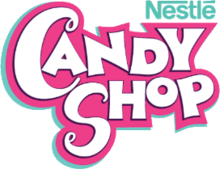Nestlé Candy Shop
Nestlé Candy Shop (formerly The Willy Wonka Candy Company) was a brand of confectionery owned and licensed by Swiss corporation Nestlé, but discontinued in 2018 when the individual brands were sold to Ferrara Candy Company.[1] The previous Wonka brand's inception comes from materials licensed from British author Roald Dahl. His classic children's novel, Charlie and the Chocolate Factory, and its film adaptations are the source of both the packaging and the marketing styles of the Wonka brand. The brand was launched on May 17, 1971, one month before the release of the novel's first film adaptation on June 30, 1971.[2] In 1988 the Willy Wonka Candy Company brand – then owned by Sunmark Corporation – was acquired by Nestlé.[3] Nestlé sold sweets and chocolate under the Willy Wonka brand name in the United States, Canada, the United Kingdom, Ireland, Australia, New Zealand, Japan, South Africa, Mexico, Colombia, Brazil, Argentina, Costa Rica, Panama, Dominican Republic and the Middle East.
 | |
| Owner | Nestlé S.A. |
|---|---|
| Country |
|
| Introduced | 1971 |
| Markets | International |
| Previous owners | Sunmark |
In mid-2015 the Willy Wonka brand name was dropped by Nestlé in favour of special "throwback" packaging before eventually renaming the entire brand as "Nestlé Candy Shop". Candies previously made by the Willy Wonka brand are now under the Nestlé brand naming, excluding the Wonka brand name on the top left corner.
Origins
The Willy Wonka Candy Company was first imagined in the pages of Roald Dahl's Charlie and the Chocolate Factory. The "Wonka" property was licensed to film director Mel Stuart; his 10-year-old daughter read Charlie and the Chocolate Factory and asked her father to make it into a film, obliging him to get "Uncle Dave" (producer David L. Wolper) to produce it. Stuart showed the book to Wolper, who was engaged in talks with the Quaker Oats Company. Wolper convinced the Quaker Oats Company into signing the deal for up to $3 million to finance the film version in exchange for the candy bar tie-in.[4] Quaker, who had previous experience in the film industry, bought the rights to the book and financed the picture for the purpose of promoting their new Wonka Bar. The name of Dahl's Charlie and the Chocolate Factory however was renamed to Willy Wonka & the Chocolate Factory for promotion purposes.
The new brand was produced by Chicago-based company Breaker Confections (a subsidiary of Quaker Oats), which in 1975 was acquired by Sunmark Corporation of Saint Louis, Missouri. The original Wonka Bars never saw store shelves due to factory production problems prior to the film's release, but subsequent Wonka product releases were highly successful. In 1980 Breaker Confections changed its name to Willy Wonka Brands in an attempt at developing its Wonka brand image before it sold out in 1986 to Rowntree Mackintosh Confectionery of the UK, who sold out in 1988 to Swiss company Nestlé, who in 1993 renamed it to Willy Wonka Candy Company.[5]
In the United States, Nestlé Candy Shop (previously The Willy Wonka Candy Company) is located today at 1445 West Norwood Avenue in Itasca, Illinois.[4] The Willy Wonka Candy Company was discontinued in September 2015 and their candy products were put under the Nestle name.
Current products
- Bottle Caps
- Everlasting Gobstopper
- Fun Dip
- Laffy Taffy
- Pixy Stix
- Spree
- SweeTarts
- SweeTarts Chewy Sours
- SweeTarts Soft & Chewy Ropes[6]
- Wonka Ice Cream (Peel-A-Pops and Push Ups)
- Mixups
- Randoms (Rowntree's Randoms in the UK, made and sold in the US under the Wonka brand)
Previous products
- Wonka Bar
- Dinasour Eggs
- Donutz
- Dweebs
- Fizzy Jerkz
- FruiTart Chews
- Nerds
- Oompas
- Punky's
- Scrumdidilyumptious
- Shock Tarts Sour Gum Balls
- Super Skrunch
- Tart 'n' Tinys
- Tinglerz
- Volcano Rocks
- Wacky Wafers
- Wonka Biscuits
- Wonka Daredevils
- Xploder
- Daredevils / Hot Gobstopper
References
- Rossolillo, Nicholas (24 January 2018). "Why Nestle Is Selling Butterfinger, KitKat, and Other American Favorites". The Motley Fool. Retrieved 28 February 2020.
- "Willy Wonka company information". Careers in Food. Retrieved 28 December 2010.
- "Nestlé Corporate History". Nestlé. Retrieved 28 March 2014.
- "At 40, Wonka Candy Is Greatest Reverse Product Placement Ever". Brand Channel. Retrieved 28 March 2014.
- J.M. Kenny (Writer, director, Producer) (2001). Pure Imagination: The Story of 'Willy Wonka and the Chocolate Factory' (DVD). USA: Warner Home Video. Retrieved 2 December 2006.
- Best, Dean (16 February 2015). "Nestle eyes liquorice market with Sweetarts NPD". just-food. Retrieved 19 February 2015.
External links
| Wikimedia Commons has media related to Willy Wonka brand. |